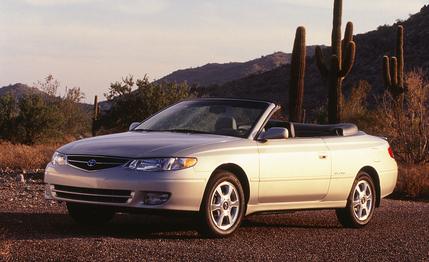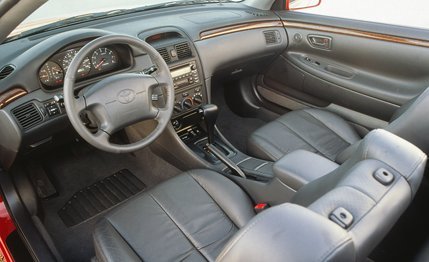
 First Drive Review
First Drive Review


Toyota has used the Camry component set as the fundamental element in so many vehicles it ought to petition for the car's inclusion on the periodic table. Since there's apparently no market niche for which the Camry cannot be tweaked, this Camry Solara convertible was inevitable. And since the Camry's solidity, stolidity, and stability carry over to everything from the Sienna and Avalon to the Lexus ES300 and RX300, that this newest variant gets those virtues too isn't a surprise.
The Camry Solara was designed by Toyota's Calty design center in California in anticipation that it would become a convertible. Why else would they have given the thing a name with sun-worshiping implications? There's nothing startling in the fixed-roof Solara's design, but whacking off the top makes it look better, with the character line high along its flanks making it appear longer than its 190.0-inch length. It's handsome, but highly unlikely to inspire much automotive bloodlust.
Handling the Sawzall for Toyota is ASC, which takes already beefed-up Solara coupe shells off Toyota's assembly line in Cambridge, Ontario, brings them to ASC's new nearby facility, and removes their roofs, further reinforces the structure, and adds hardware to accept the top. The shells then return to Toyota to complete their trip through the paint process, and the drivetrain and interior are installed. After that, it's back to ASC, where the power tops, retractable rear quarter-windows, and some trim are bolted on. ASC has decapitated Celicas since 1983, and the 2000 Solara convertible effectively replaces that car in Toyota's lineup. Toyota claims the convertible's torsional rigidity is such that there was no need to change the calibration of the coupe's all-independent suspension.


ASC's softtop is fully lined and power-operated and features a good-size heated glass rear window. The top doesn't strictly mimic the coupe's roofline, and the now-retractable rear quarter-windows are smaller than those fixed on the all-steel car, so peripheral vision is compromised with the top raised. Aesthetically, the top looks okay in either black or "camel," but the soft tonneau under which it lives is a hassle to wrestle into place. The result bulges noticeably above those handsome flanks.
Dropping the top is a matter of unlocking a latch at each side of the windshield header and hitting the button on the center console. Over the next 30 or so seconds, the top retracts, the quarter-windows disappear, and the atmosphere comes in. But the top sucks up some trunk space, and the thicker interior side panels encroach on hip and shoulder room. Three can sit in the back, but it's tight.